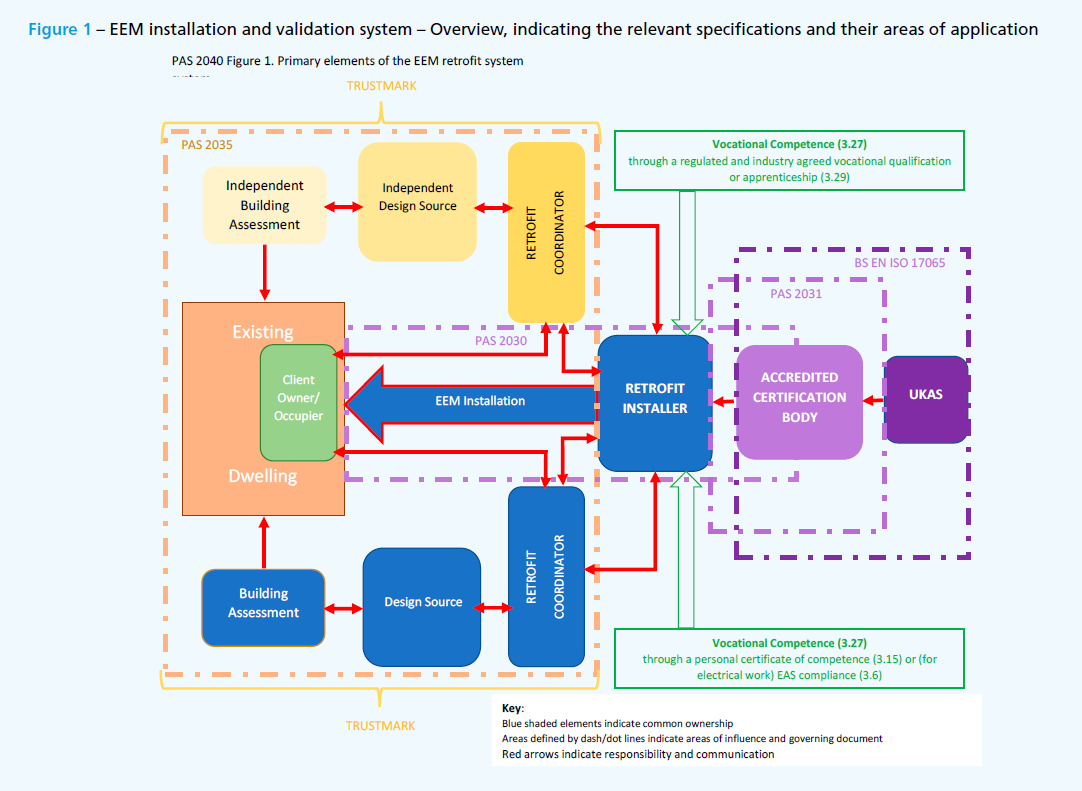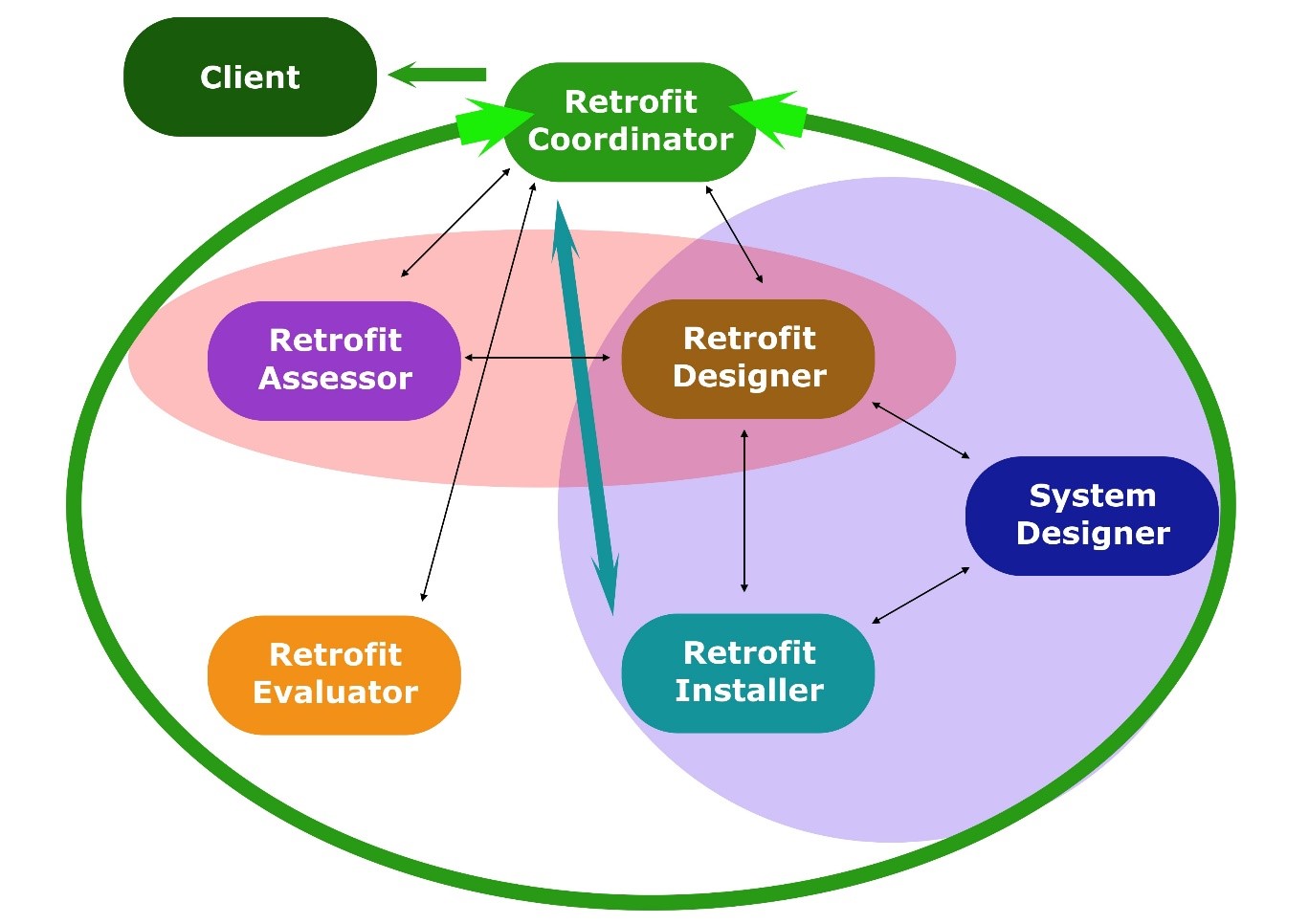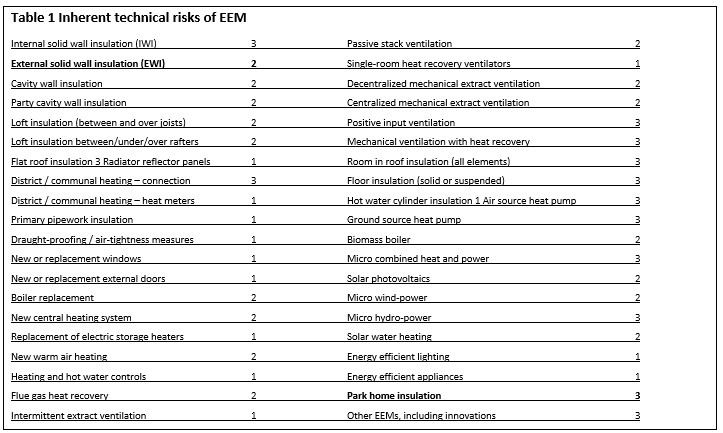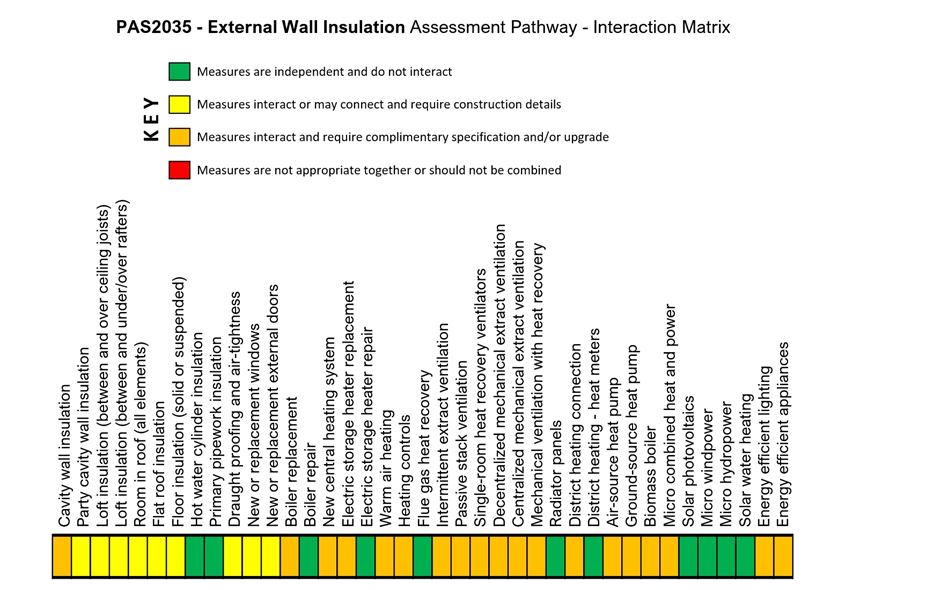EWI & PAS 2035 / 2030 +A1 : 2022 – A Brief Overview To What You Need To Know
If you’re an external wall insulation installer, an EWI system designer or a professional involved in the retrofit market you’ll need to know about PAS2035/2030+A1. The feature below will give you a brief overview of everything you’ll need to know about it when it comes to EWI.
If you prefer you can Download A PDF Copy >>>.
What is PAS2035/2030+A1?
PAS2035/2030+A1 is the new over-arching government document in the retrofit standards framework, with which users of the TrustMark Government endorsed quality scheme are required to comply when carrying out funded domestic retrofit work. This was introduced following the recommendations of the Government commissioned Each Home Counts review and provides a specification for the energy retrofit of domestic buildings and best practice guidance for the design, survey, installation, hand-over and record keeping.
PAS2035/2030+A1 is expected to become the mandatory standard framework for all retrofit energy efficiency measures which are installed under ECO or any other Government funded scheme.
The relationship to PAS 2030
Designs for the installation of retrofit measures in domestic buildings that are prepared in accordance with PAS2035/2030+A1 are required to be installed, commissioned and handed over in accordance with PAS 2030, or in some cases in accordance with the Microgeneration Certification Scheme (MCS) standards. Whilst PAS2035/2030+A1 provides the design framework, only PAS 2030 certified organisations will to be able to install the measures.
Gaining PAS 2030?
A lot of the process for gaining PAS 2030 is based around the requirement for a robust quality management system and specifics regarding the installation of the energy efficient measures. PAS 2030 sets out core requirements to be met and supplementary requirements for each measure type.
The key difference with PAS 2030 is that it is designed to coordinate with PAS2035/2030+A1 and in particular to the new structure involving Retrofit installers, Retrofit Coordinators, Retrofit Designers, Retrofit Evaluators, Retrofit Advisors and Retrofit Assessors; although many of these roles can be carried out by the Retrofit Coordinator.
The assessment for gaining PAS 2030 will generally involve an office audit to verify your quality management system. The QMS should have details of a Retrofit Co-ordinator and Retrofit Assessor as part of the organisational chart, along with the appropriate forms and procedures.
Following the office audit, a site assessment will be required, which if planned correctly could take place on the same day as the office audit, otherwise a further assessment will be required to complete the company’s compliance with the scheme.
Once your business has successfully complied with the PAS 2030 assessment, you will then need to register with Trustmark to undertake retrofit works.
The Retrofit roles.

The Retrofit Coordinator
The role of the Retrofit Coordinator is one of the responsibilities of overseeing a project from inception to completion including all advice given. Within this remit the Retrofit Coordinator is responsible for the following:
- The risk assessment.
- Medium-Term Improvement Plan.
- The dwelling assessment.
- The retrofit design.
- Installation.
- Post-completion and evaluation.
- Claiming compliance with PAS2035 – lodging projects in data warehouses via TrustMark
A critical element of PAS2035/2030+A1 is the risk assessment carried out by the Retrofit Coordinator on the dwelling to identify the level of risk associated with the retrofit, with grades given on the overall risk from A (low), B (medium) and C (high). The level of risk for the scheme will dictate the level of competency required by other roles and also the requirement for greater design input from a system designer.
Please see the section regarding Risk Assessment Pathways.
The Retrofit Assessor
The Retrofit Assessor is responsible for the assessment of the buildings in-line with the identified risk path identified by the Retrofit Coordinator.
Whole dwelling assessments, which will include ventilation assessments will be recorded and issued to the Retrofit Coordinator and Retrofit Designer along with any Standard Assessment Procedure (SAP), Reduced Data Standards Assessment Procedure (RDSAP) or Passive House Planning Package (PHPP). The Retrofit Assessor will also be responsible for producing a full photographic record of the building features and any potential identifiable defects.
When EWI is a potential energy efficiency measure to be installed, the Retrofit Coordinator should ensure the exact construction through the wall is established to enable accurate U-Value calculations.
For pre-1919 built properties, it is advisable to undertake a historical building checklist.
The Retrofit Designer
The Retrofit Designer is responsible for the preparation of the package of information regarding the energy efficiency measures and their interrelationship, that are going to be installed in a building in order to achieve the specified efficiency targets.
Depending upon the risk path assessment, then the mandatory competency requirements for the Retrofit Designer will alter. The retrofit design is to be reviewed by both the Retrofit Coordinator and Retrofit Installer prior to installation.
The Retrofit Evaluator
The Retrofit Evaluator is a person qualified to monitor and evaluate the effectiveness of the measures installed and the overall retrofit project. The monitoring has 3 levels: basic, intermediate and advanced and the level of monitoring required will be determined by the client and the Retrofit Coordinator, if they believe the intended outcomes are not being achieved.
How are projects delivered under PAS2035/2030+A1?
PAS2035/2030+A1 specifies requirements for retrofit of dwellings, including:
- assessment of dwellings for retrofit;
- identification and evaluation of improvement options (energy efficiency measures, or EEMs);
- design and specification of EEMs (whether individual measures or packages of multiple measures)
- monitoring and evaluation of retrofit projects.
The Retrofit Installer is expected to deliver the installation of the energy efficiency measure in accordance with PAS2035/2030+A1 and in doing so will now have to coordinate all information through a Retrofit Coordinator.
The diagram below shows the interaction between the parties under PAS2035/2030+A1.

Diagram is taken from the British Standards Institute document PAS 2030:2019.
What are some of the key points to know being a Retrofit Installer?
It is important to familiarise yourself with PAS 2030: (B4 Measure BFM.4 External Wall Insulation). This sets out the following criteria’s:
- Additional installation requirements.
- Pre-installation building inspection requirements.
- Inspector competence.
- Operative competence.
- Provision of information in respect to external wall insulation.
Additional installation requirements
The Installer shall ensure that the methods used for the installation of external wall insulation (EWI) products or systems are as recommended by the system supplier and in accordance with the relevant retrofit design and incorporated in the installation method statement.
Pre-installation building inspection requirements.
To ensure that a full pre-installation assessment has been carried out by a competent person (as defined the relevant table in PAS 2030). That all designs have been produced in accordance with the PAS and any identified non-compliance has been officially notified to the Retrofit Coordinator.
Inspector competence.
As defined within PAS 2030 as holding a regulated and industry agreed, vocational qualification or apprenticeship, or a personal certificate of competence relating to the measure.
Operative competence
As defined within PAS 2030 as holding a regulated and industry agreed, vocational qualification or apprenticeship, or a personal certificate of competence relating to the measure.
For each installation task to be undertaken, the installer shall employ or subcontract at the particular location, at least one vocationally competent operative. For each installation, the vocational competence ratio shall be determined by the installer in relation to the:
- a) range, scale, geographical spread and complexity of the work being undertaken; and
- b) supervision and experience of the individual that meets the vocational competence requirements for the relevant tasks and the relative experience of the operatives being supervised; but shall not be less than one qualified operative per team of 4 (1 qualified to 3 non-qualified), at the specified installation location at any time.
Provision of information in respect to external wall insulation.
The Retrofit Installer will be responsible to the measure specific information including user/maintenance manuals, compliance certification and warranties/guarantees, and the explaining of the above in person to the homeowner / occupier.
Interaction Map
Under PAS2035/2030+A1 the Retrofit Coordinator is responsible for the whole process, with all roles reporting into them. Within the various retrofit roles, there are important connected roles for production and sharing of information and data. The Retrofit Coordinator reports into the client and currently can be employed by the client or the Retrofit Installer. It is also possible for the Retrofit Coordinator to assume some of the other roles depending upon the risk assessment path.
With System Designers their responsibilities are mainly with the Retrofit Designer and the Retrofit Installer. It is possible that the client will have preference as to the System Designer they wish to use and therefore communication channels may exist, but the PAS2035/2030+A1 interaction map graphic below helps with the understanding of the main relationships.

Risk Assessment Pathway
The risk assessment determines which of three paths a PAS project will be required to undertake.
Path A (low risk) This is for simple projects involving very few measures, such as a single domestic low-rise property with EWI.
Path B (medium risk) This is for projects with more stringent requirements, such as multi-measure schemes. Path B would be the most common path for EWI.
Path C (high risk) This if for projects involving high-rise, protected buildings or large schemes that require significant management, which involved the most technical risk.
The risk assessment takes into account a number of elements based upon a point scoring system such as:
- The number of dwellings to be improved.
- The number of measures per dwelling
- The inherent technical risk for the measure (or highest risk measure if multi-measure, see below Table 1)
- The highest risk combination of measures.
- The construction and built form.
From all the data gathered on the scheme, the Retrofit Coordinator will decide upon the risk Assessment path.
Table 1 – Inherent Technical Risks – All Measures

If the installer operates under an industry quality assurance scheme that is compliant with cause B.6 of PAS2035. This allows for the technical inherent risk score in table 1 to be reduce by a value of 1.
As part of the risk assessment the interaction with other measures to be installed have to be taken into account. The figure below is based purely on external wall insulation and its interaction with other measures.

Re-produced from PAS2035:2019 Figure D.1 – The measures interaction matrix
How will this affect your business?
There is a cost for the assessment and maintaining of PAS 2030; however, to install retrofit energy efficiency measures this is necessary. There is no direct cost with regard PAS2035/2030+A1 but indirect costs due to the framework compliance can be expected.
The requirement of 1 in 4 operatives having a qualification which would be at a level of NVQ level 2 Boarder or Finisher does carry a cost as well as time. The demand for more compliance, paperwork, record keeping and specifically working with the Retrofit Coordinator and others could require extra personnel as a business.
Depending upon the scheme itself, the costs of the Retrofit Coordinator etc would have to be included within the original tender from the Retrofit Installer.
For the more medium to large scale businesses within the retrofit of external wall insulation industry, the compliance with PAS2035/2030+A1 really should not propose too many issues. For the smaller installers the requirement for qualifications, record keeping and the greater reliance on administrative processes and procedure could be an issue.
What responsibility is there for system designers?
The PAS2035/2030+A1 framework is about responsibility, compliance and data. It is therefore important to know that each scheme will require a full set of specifications, details and calculations. PAS2035/2030+A1 also focuses on thermal bridging, and it is important that system designers familiarise themselves with the document ‘External wall insulation specification for weathering and thermal bridge control – guide. May 2019,’ as this document is referenced in PAS2035/2030+A1.
If the design conforms to the Green cold bridge details, then there is no change to the risk group, if however, the amber cold bridge detail is to be adopted then the risk profile in
There is a requirement to produce site specific supporting data for wind loadings, fixings requirements and condensation analysis.
PAS 2030 states that ‘All work is carried out in accordance with the site-specific retrofit design, drawings and method statement and that work is not permitted to progress unless copies of the site-specific specification documentation are accessible at location and all operatives are aware of the content and requirements relevant to their designated activities;
The system and all detailed interfaces with other parts of the dwelling or other planned EEMs to be undertaken in a manner and sequenced such, that all measures are fully effective, with optimized performance and junctions that are safe, durable and fully weatherproof for all expected exposure conditions. e.g., interface between EWI system and planned replacement windows; and
Whether or not specifically required by the retrofit design, the items listed in i to viii below are given particular attention with regard to the efficacy and durability of the detail especially concerning the management and exclusion of moisture and/or the risk of surface/interstitial condensation or rising damp. Mastic sealants shall always be supported by a primary seal below, and all details shall be fully weatherproof:
System base detail (including below dpc);
- ii. Interfaces with roofs at eaves and verges (where metal or plastic cappings and trims shall not be used); unless these are detailed within the document ‘External Wall Insulation Specification for Weathering and Thermal Bridge Control’; (this means that verge trims can now be used, but only if the installation complies with the aforementioned detail).
iii. Window/door reveals/heads;
- System/cill interfaces (incl. overhang requirements/weepholes/thermal movement);
- Surface fixtures (structurally sound);
- Penetrations through the system;
vii. Interfaces with roof soffits, flat roofs, conservatory roofs etc.; and
viii. Detailing and sealing around vents/flues, meters and other heating related structures/pipework.
All weather seals at the interface between EWI systems and other structures/finishes are installed with particular attention given to the soundness/cleanliness of contact surfaces, continuity and effectiveness around corners, bond to surfaces and the durability of the water seal;
All details are installed to minimize the risks of thermal bridging, removing/relocating/extending to allow continuity of insulation in all cases e.g. rooflines, meter boxes, pipework, flues, ducts.’
Any proposed variations on the project, which have an impact of the EWI system must be referred back to the system designer to confirm in writing or by the re-issue of a detail drawing.
Insulating below the dpc
Within the issue of PAS2035/2030+A1 there has been a change to the criteria of insulating below the dpc. There is now no need to insulate below the ground level if the ‘External Wall Insulation Specification for Weathering and Thermal Bridge Control’ guidance document is followed. This will allow for the following:
- Solid floor properties can be insulated to 10mm above ground and comply.
- Suspended timber floor properties also should be insulated to 10mm above ground but require ventilation to be continuous fan, and rooms need to be heated to min 18°C (advice to homeowner).
- If the suspended timber floor is not insulated at the time of installing the EWI system, then the insulating of the floor should be notified in the Medium-Term Improvement Plan.
